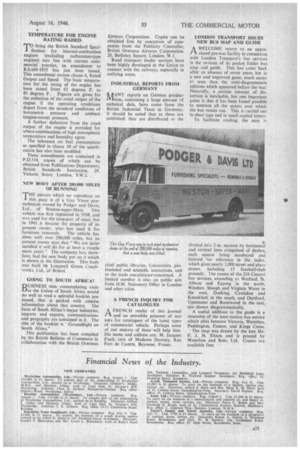TEMPERATURE FOR ENGINE RATING RAISED
Page 25

If you've noticed an error in this article please click here to report it so we can fix it.
To bring the British Standard Specification for internal-combustion engines (excluding carburetter-type engines) into line with current commercial practice, an amendment to B.S.649-1935 has just been issued. This amendment revises clause 4, Rated Output and Speed. The basic temperature for the rating of the engine has been raised from 62 degrees F. to
85 degrees F. Figures are given for the reduction of the rated output of the engine if the operating conditions depart from the standard conditions of barometric pressure and ambient (engine-room) pressure.
A further deduction from the rated output of the engine is provided for where combinations of high atmospheric temperature and humidity agree.
The tolerance on fuel consumption as specified in clause 10 of the specification has also been modified.
These amendments are contained in P.D.514, copies of which can be obtained from Publications Department, British Standards Institution, 28. Victoria Street. London. S.W.1.
NEW BODY AFTER 200,000 MILES OF RUNNING
THE picture which we reproduce on this page is of a Guy Vixen pantechnicon owned by Podger and Davis. Ltd.. of Weston-super-Mare. This vehicle was first registered in 1938, and was used for the transport of meat, but in 1941 it became the property of its present owner, who has used it for furniture removals. The vehicle has done well over 200,000 miles, but its present owner says that " We are quite satisfied it will do for at least a couple more years." The company has, therefore, had the new body put on it which is shown in the illustration. This body was built by 1.ongwell Green Coachworks, Lid., of Bristol.
GOING TO SOUTH AFRICA?
BUSINESS men .contemplating visits to the Union of South Africa would do well to read a splendid booklet just issued, that is packed with concise information about that country. The facts of South Africa's major industries, imports and exports, communications and geography are contained in it. The title of the booklet is " Groundlight on South Africa."
This publication has been compiled by the British Bulletin of Commerce in collaboration with the British Overseas Airways Corporation. Copies can be obtained free by executives of companies from the Publicity Controller, British Overseas Airways Corporation, 20, Berkeley Square, London, W.1.
Road transport feeder services have been highly developed in the Union to connect with the railways, especially in outlying areas.
INDUSTRIAL REPORTS FROM GERMANY
NAANY reports on German producIVItion,. containing a large amount of technical data, have come from the British Industrial Team in Germany. It should be noted that as these are published, they are distributed to the
chief public libraries. Universities, professional and scientific institutions, and to the trade asscciations concerned. A limited number is also on public sale from H.M. Stationery Office in London and other cities A FRENCH INQUIRY FOR CATALOGUES
AFRENCH reader of this journal and an erstwhile prisoner of war asks for catalogues of the latest types of commercial vehicle. Perhaps some of our makers of these'will help him. His name and address are: M. Jacques Fuzil, care of Madame Durroty, Rue Fort de Castets, Bayonne, France.
LONDON TRANSPORT ISSUES NEW BUS MAP AND GUIDE
AWELCOME return to an appreciated pre-war facility in connection with London Transport's bus services is the re-isstie of its pocket folder bus map and guide. This has come back after an absence of seven years, but in a new and improved guise, much easier to scan than the semi-diagrammatic editions which appeared before the war. Naturally, a .certain amount of distortion is inevitable, but one important point is that it I.as been found possible to mention all the streets over which the bus routes run. This is carried out in clear type and in small capital letters.
To facilitate reading. the map divided in:o 2-in, squares by horizontal and vertical lines aimprised of dashes, each square being numbered and lettered for reference in the index, which gives nearly 2,000 street and place names. including 15 football-club grounds. 1 he routes of the 234 Central bus services, extending to Watford, St. Albans and Epping in the north. Windsor, Slough and Virginia Water in the west, Dorking, Coulsdon and Knockholt in the south, and Dartford, Upminster and Brentwood in the east, are. shown diagrammatically.
A useful addition to the guide is a timetable of the inter-station bus service which plies between Victoria, Waterloo, Paddington, Euston, and Kings Cross.
The map was drawn by the late Mr. F. J. H. Elston and is printed by Waterlow and Sons, Ltd. Copies are available free.




































































